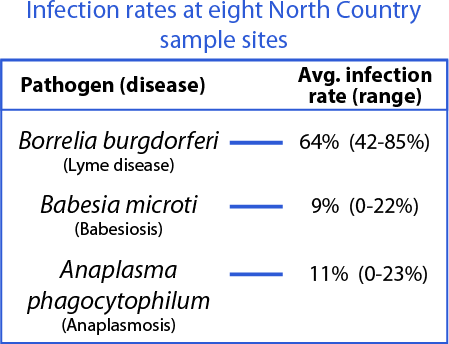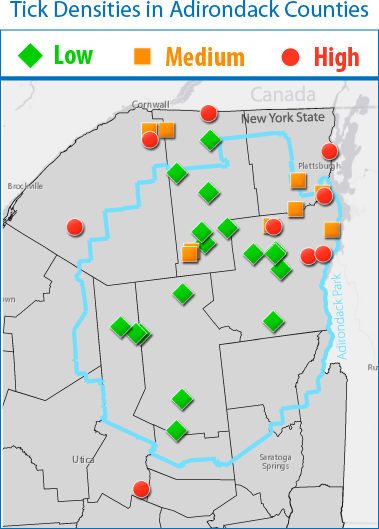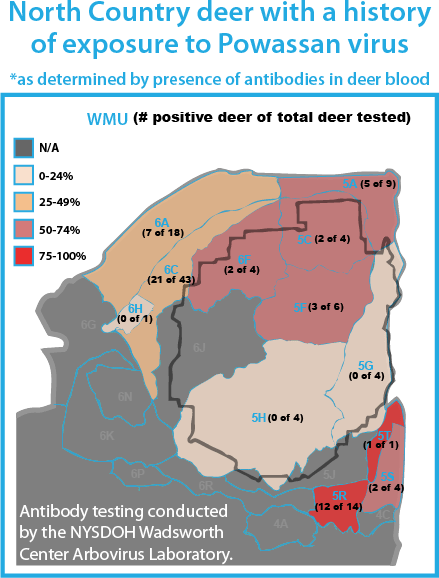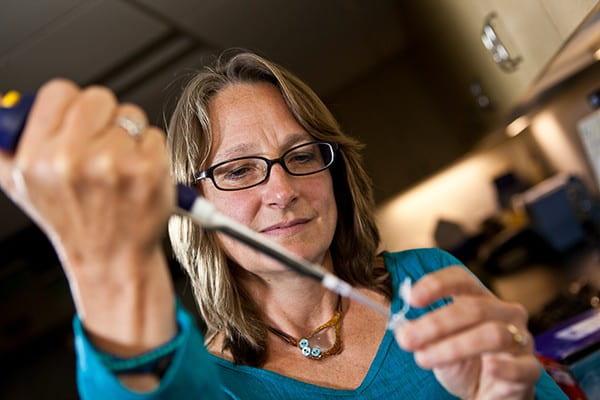Tick Research
This work is done in collaboration with the New York State Department of Health and Wadsworth Center Arbovirus Laboratory.
Tick-borne Diseases
Since 2015, Paul Smith’s College’s Adirondack Watershed Institute has surveyed for blacklegged ticks (Ixodes scapularis) at over 40 sites in six North Country counties (Clinton, Essex, Franklin, Hamilton, Herkimer and St. Lawrence). Blacklegged tick density was highest at the lowest elevations, but ticks were also found at higher elevations sites (exceeding 1600 feet). Tick populations are still patchy, but there is risk of encounter throughout the North Country.
In 2018, 546 ticks collected from eight sites in the North Country were tested for human pathogens, including those that cause Lyme disease, babesiosis and anaplasmosis. Infection rates are shown in the table below. At several sites, including locations in Essex County, approximately a quarter of ticks were found to be infected with more than one pathogen, and a small percentage of ticks were found to be infected with all three pathogens.


Powassan Virus
Powassan virus disease is a rare, but sometimes serious, disease that is caused by Powassan virus (POW) or Deer tick virus (DTV), and is transmitted through the bite of infected ticks. Systematic surveillance for POW/DTV in the North Country was conducted for the first time in Fall 2018. The most sensitive method involves testing blood from hunter-harvested deer for presence of antibodies, which indicates prior exposure to the virus. Over 100 blood samples were collected, and on average 40% of North Country deer showed evidence of POW/DTV exposure. The geographic distribution of samples collected by wildlife management unit (WMU), and results of antibody testing, are shown in the map below. This indicates there is risk of Powassan virus disease in the North Country. Risk in this region is still lower than some other areas of the state where the majority of deer test positive.

Incidence of Lyme Disease in the North Country
Incidence of Lyme disease throughout New York State has remained fairly steady over the past two decades, incidences have risen sharply in the North Country. From 2010-2017, the incidence of Lyme disease in humans increased in all North Country counties.


Contact »
Lee Ann Sporn, Ph.D.
Professor, Biology
Paul Smith’s College
Paul Smiths, NY 12970
lsporn@paulsmiths.edu
518-637-2279 (cell)
518-327-6326 (office)
Research in the News
PSC team tracks ticks, educates kids and informs the state
As ticks and disease spread north, monitoring is threatened
Adirondack Explorer
Essex County a tick hotbed
Sun Community News
New ticks, new questions
The Press Republican
Deer Ticks Showing up in high elevation communities
Adirondack Explorer
PSC students want your (deer) blood
Adirondack Daily Enterprise
Deer blood sought for Powassan study
The Press Republican
Tri-Lakes Takes: Tick research and new health threats
North Country Public Radio
